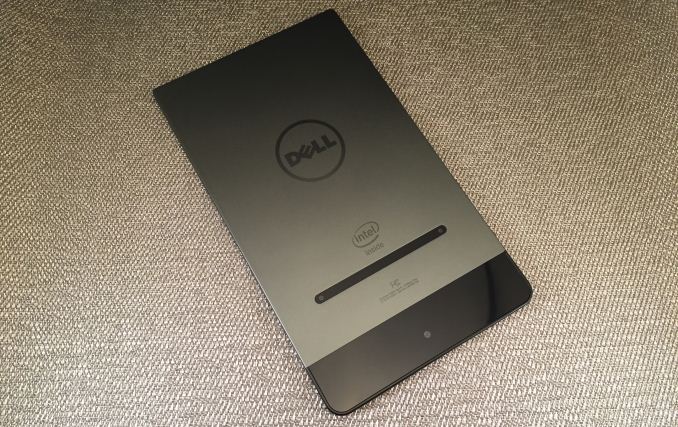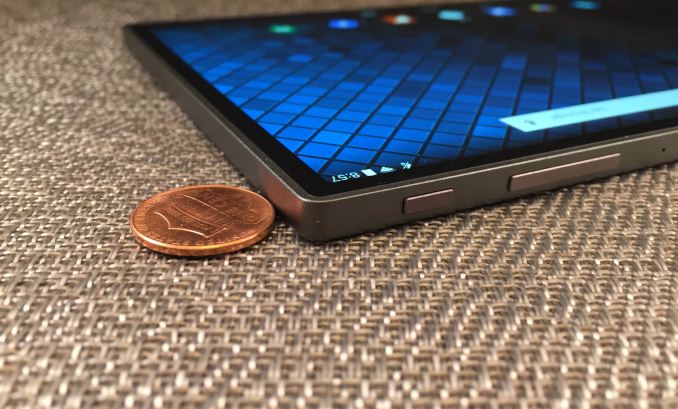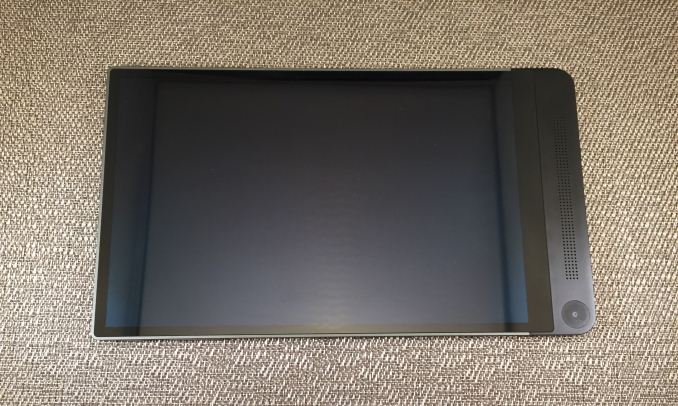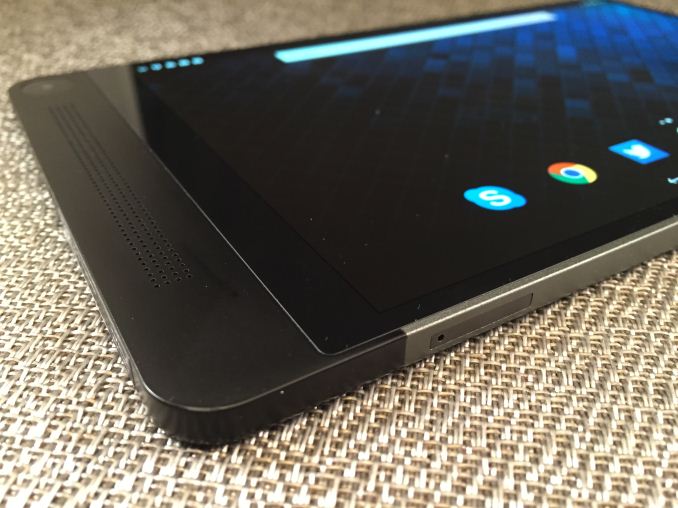The Dell Venue 8 7000 Series Review
by Brandon Chester on March 12, 2015 8:00 AM EST- Posted in
- Tablets
- Dell
- Android
- Mobile
- Venue 8 7000

Five years ago, the first of what we would call modern tablet computers were released to the world. What is now an entire product category was originally seen with massive skepticism by many consumers, analysts, and journalists. Even those who had high hopes for the future of tablets could not have predicted their meteoric rise in popularity and ubiquity.
Although tablets are still derided by many as being useless for productivity work, there are many cases where a consumer has been able to not just supplement, but replace their traditional computer with a tablet. Of course, as tablets made by companies in the mobile space replace traditional computers, the producers of those computers are faced with a problem of maintaining profit and relevance. The inevitable move was for PC companies to produce their own tablets to compete with their new competition.
This brings us to the Dell Venue 8 7000 Series tablet, also known as the Dell Venue 8 7840. Although there have been other Venue 8 tablets, for the remainder of the review I will refer to the Dell Venue 8 7840 as the Venue 8 as the full name is quite long and there shouldn't be any risk of confusion with older Venue 8 tablets. Dell is actually not a brand new player in the tablet space, nor are they new to the mobile space.
Some people may remember the Dell Streak 5, which was a 5" phone that could be called one of the first phablets on the market. However, Dell is still not a well known player in the mobile space despite their previous attempts to break into it. On paper, the Venue 8 has all the attributes required of a flagship tablet, but whether or not it's enough to make Dell a serious contender remains to be seen. Before discussing the design of the Venue 8, I've laid out its specifications below to give an overview of how the Venue 8 stacks up to the competition.
| Dell Venue 8 7840 | |
| SoC | Intel Atom Z3580 Moorefield quad core Atom with 2.33GHz burst speed, PowerVR G6430 |
| RAM/NAND | 2GB LPDDR3, 16GB NAND + microSDXC |
| Display | 8.4" 2560x1600 AMOLED |
| Dimensions | 215.8 x 124.4 x 6.0 mm, 306g |
| Camera | 8MP Rear Facing + 2x 720p Depth Cameras 2MP Front Facing |
| Battery | 5900mAh (21Wh) |
| OS | Android 4.4.4 KitKat |
| Connectivity | 1x1 802.11a/b/g/n/ac + BT 4.0 , USB2.0 LTE SKU Available |
| Price | Starting at $399 |
As you can see, the Venue 8 is a high end device in most areas, at least when evaluated on paper. The limited storage configuration of 16GB is one of the few question marks, though the microSD slot helps; the GPU is also going to be potentially limiting. Note that Dell also offers an optional wireless keyboard/case as an accessory. The rest of the review will determine how well these specifications translate into a good real world experience, but before jumping into the technical details it's important to discuss the design and ergonomics of the Venue 8.
One big selling point for the Venue 8 is that it's currently the thinnest tablet in the world according to Dell. Both Apple and Sony have tablet offerings that are 6.1mm thick, but Dell has shaved off that decimal point and made a tablet that is exactly 6mm thick across the entire chassis. I can't really tell the difference between the thickness of the Venue 8 and the iPad Air 2, but both devices are remarkably thin. The Venue 8 feels even more impressive than the iPad at times because it's smaller and significantly lighter in addition to being thinner. The bulk of the chassis is made of aluminum, with a small plastic region at the bottom to house the speakers and camera. The whole device feels great in the hand, and the aluminum feels solid and sturdy.
However, there is a unique aspect of the Venue 8's design that needs to be addressed, which are the unconventional bezel proportions and speaker positioning. On most tablets, you'll see a bezel of equal width on every side, or a a pair of equal bezels on the top of bottom, and a pair of equal thinner bezels on the left and right sides that are thinner than those on the top and bottom. The Venue 8 with its Infinity Display instead opts to use very thin bezels of equal width on the top, left, and right, and a thicker bezel on the bottom. This is necessary to provide space for the various circuitry and display drivers that are required. In addition, Dell has placed the front-facing camera and a pair of stereo speakers in a section beneath bottom bezel.
This leads to an unconventional and unfortunately unbalanced bezel design, and it can cause some issues when holding the tablet. In portrait mode the fact that there's a larger bezel and a speaker at the bottom of the tablet doesn't pose much of an issue, but in landscape mode it makes it uncomfortable to hold. It's hard to hold the Venue 8 in landscape without it feeling uneven. This is exacerbated by the fact that the bezel on top of the tablet is extremely thin.
The thinness of the other bezels can also pose their own issues with having fingers rest on the display. When Apple first used asymmetric bezels on an iPad with the iPad Mini, they tweaked the touch rejection in iOS to account for the fact that fingers were more likely to be resting on the display. Android has no such accommodation, and there have been instances where I find myself unable to scroll or accidentally zooming because one of my other fingers is resting on the display and being detected as touch input.
Overall, I think the Venue 8 is a well designed device with exceptional build quality. It feels remarkably thin and light in the hand, and its flat edges are visually striking while still remaining ergonomic due to the tablet's thinness. The aluminum construction also ensures that there's not even the slightest bit of flex to the chassis. Like every device, it's imperfect. The bezel design is visually impressive, but hampered by technological limitations and some software issues. I also have mixed feelings about the camera placements. Despite its issues, the Venue 8 still remains a tablet that both looks and feels like a premium device.













89 Comments
View All Comments
darkich - Thursday, March 12, 2015 - link
your Intel *bias*Michael Bay - Thursday, March 12, 2015 - link
Consider how faster Atom became when Baytrail came. That`s generational improvement the article is talking about.Intel also always will be on superior process node compared to everyone else.
It`s only a question of supplying better GPU part.
lucam - Thursday, March 12, 2015 - link
This GPU is good, but not enough maybe for a tablet.darkich - Friday, March 13, 2015 - link
Lol.Consider how faster Cortex became from A9-A72. Around 400%.
Astonishing achievement that Intel can only have pipe dreams about.
LukaP - Friday, March 13, 2015 - link
Considering Intel managed to get Broadwell into 4.5W space i wouldnt be too worried about them. Their next gen atoms will be on par with any arm design. Dont forget that they have atleast one node advantage (with 10nm that will be two nodes) and ALOT more money to pour into RND.Look at what they are doing with iGPU performance. they realised AMD was stealing their market there, and came up with the Gen8 Iris Pro.
Same will happen in mobile. when intel wants something it takes it. Plus it helps that they can rely on the Intel Inside branding.
pSupaNova - Friday, March 13, 2015 - link
Every generation we hear the same arguments spouted by the Intel Crowd, then when the mobile products hit the market ARM based Socs beat Intels hands down.Intel can't own this market big players like Samsung & Apple who manufacture devices and design ARM SOCS will not let them gain a big enough foothold in the market.
The Mobile SOC race is over ARM won and Intel are now scrambling for the scraps.
Michael Bay - Friday, March 13, 2015 - link
Samsung SoCs are the ones scrambling for the scraps even within Samsung lineup, and Apple will always will be a thing in itself.This battle is far from over, and rushing to proclaim someone a winner only uncovers one`s uncertainty.
darkich - Friday, March 13, 2015 - link
That 4.5W Broadwell costs over $250, and is matched(in raw computing performance) by a $50 2W Exynos 7420, and almost matched by last year's 20nm A8X..Seriously, there is no competition whatsoever. Facts are overwhelmingly in favor of ARM based chips.
darkich - Friday, March 13, 2015 - link
Also, so far Intel always had a node advantage but trailed behind ARM despite of that.Now even that advantage is melting away.
Samsung is actually the first to have tested a 10nm process
Michael Bay - Friday, March 13, 2015 - link
Intel process advantage "melting away"?Nice mantra.
It took them literally years and years to get where intel was two years ago process-wise, and then it`s not even real 14nm. You`ll get years after years of Samsung milking it completely dry, then TSMC yields will finally catch up and they`ll have to think about moving to 10.
Intel will be somewhere below 5 by then.